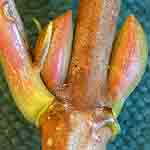|
Viburnum leaf
beetle home
Guide to identifying Viburnums
Common
names
Is
it a viburnum?
Which
viburnum?
Express key
ID
tutorial
Guide to viburnums by David Swaciak.
Leaf drawings by
Marcia Eames-Sheavly.
Logo
images by Paul Weston & Craig Cramer
|
Look
at the twig between the petioles (leaf stems). (This is best seen on newest
growth.)
7A1.
If the base of the petioles are
not connected by a line (right), you
do not have a viburnum.
|
|
7A2.
If the base of the petioles
are connected by a line (easier to see on older twigs), go
to 8. |

Click for larger, labeled image. |
Tip: Not all viburnums have a line between the petioles.
If you chose 7A1 above, your plant is most likely a:
- Butterfly bush (Buddleia sp.)
More information, pictures from UConn
- Beautyberry (Callicarpa sp.)
More information, pictures from Cornell | UConn
- Beautybush (Kolkwitzia sp)
More information, pictures from Cornell | UConn
- Amur Privet (Ligustrum amurense sp.)
More information, pictures from Cornell | UConn
- Border Privet (Ligustrum obtusifolium sp.)
More information, pictures from Cornell | UConn
Search UConn for more Ligustrum species
- Common Buckthorn (Rhamnus cathartica sp.)
More information, pictures from Cornell | UConn
- Alder Buckthorn (Rhamnus frangula sp.)
More information, pictures from Cornell | UConn
© Copyright, Department of Horticulture, Cornell University.
Project coordinator: Lori Brewer, ljb7@cornell.edu
Website design: Craig Cramer cdc25@cornell.edu
Mention of trade names and commercial products is for educational
purposes; no discrimination is intended and no endorsement by Cornell
Cooperative Extension or Cornell University is implied. Pesticide
recommendations are for informational purposes only and manufacturers'
recommendations change. Read the manufacturers' instructions carefully
before use. Cornell Cooperative Extension and Cornell University assumes
no responsibility for the use of any pesticide or chemicals. Some
of the links provided are not maintained by Cornell Cooperative Extension
and Cornell University. Cornell Cooperative Extension and Cornell
University are not responsible for information on these websites.
They are included for information purposes only and no endorsement
by Cornell Cooperative Extension or Cornell University is implied.
Cornell Cooperative Extension provides equal program and employment
opportunities. |